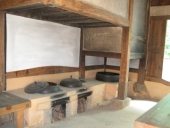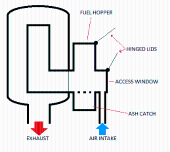Replying to a dinosaur post—but figured more folks might need same info…
A few years back, someone was selling steel, tiny, vented rocket stoves that could have a stainless steel cook top added.
These were tiny enuf to use, fixed-mounted & shielded, inside an RV, using 4” pipe exhaust.
I think it was this company:
https://shtfandgo.com/product-category/bullet-proof-rocket-stoves/ , but just looked, & they were not showing the S/S add-on vent-insert cooktops—I’d ask them, tho.
But you have clay…I suggest experimenting.
Outside!
Dig up some clay—about enuf to fill a 5 gal. bucket.
It needs to be hydrated in a container of water, to make it workable.
It then needs worked, wet, to make it like thick mortar.
Clay shrinks as it dries; best method is, thoroughly mix-in course sand, to reduce shrinkage/cracking.
Can use recycled tin cans of various sizes as the forms/permanent coverage of clay.
Can use heavy-duty concrete blocks & clay bricks mortared together with clay.
Can use some kinds of rocks mortared with clay.
Clay should also coat the fire path, to protect the blocks or bricks.
If only using clay, it needs totally dried before firing, to minimize cracking, similar to working ceramics: form unit, let dry; if it cracks, add more clay & air-dry again, til no cracks. Then test-fire it. Firing it tempers clay into ceramic.
Clay layer on outside of the unit, adds mass that can hold some heat.
I’m in the PNW, too.
Used a few 8x8x16” concrete blocks & random bricks & rocks + clay from site, inside a tiny cabin.
The firebox & smoke path were same size as exhaust pipe (about 4”), but, the fire chamber can be ..slightly.. larger.
The basic design is a “J”.
Making that shape, gets it to “rocket” (the sound, & the heat that makes it very efficient).
Must be coupled with exhaust pipe of enuf length to get a good “draw” of air. Commonly, a 4” exhaust pipe…I used single-wall chimney pipe parts at the stove, then hooked that to the heavy duty drier vent to slinky over to the 6” chimneypipe already installed—but coulda routed it out the upper wall.
Tiny rocket stoves’ exhaust only needs to be about 8’ or more high; the regular size rocket stove in our house, needs a 15’ high 6” chimney liner.
Avoid putting exhaust pipe thru roof in RVs—avoid making holes in the roof, cuz RV roofs, especially, are prone to leaks—& esp. in the PNW.
Must have outside air brought in to the burn chamber, or right in front of it, via a heat-proof tubing, to help burn fuel right—even in our kinda leaky tract house, our rocket stove required outside air; so did the little one at the cabin (weathered-in, not “tight”). I used aluminum duct parts & heavy duty drier venting to bring air to the fire.
1st, tried different ways to stack the blocks to form a fire path; it requires cutting a block or two, to get it right.
I used our site clay + silty dirt to grout between blocks, & to coat the fire path, & slathered the outside.
I mix in about 50/50 clay & silt, to reduce cracking.
I wanted a cooking area, so laid a (paver, recycled iron griddle or pan, etc.), to make a flat surface to place a cookpot.
Some make a pot-hole thru to the fire chamber, to exactly fit a dedicated pot over the fire chamber, & a lid to cover that when not cooking.
With clay coating firepath to the chimney connection, can custom fit a 4” pipe to that, & use same directions & cautions needed to install chimney vent.
RV walls are thin; you don’t know where the frame, wiring, etc are, inside wall—those need avoided.
Vent needs to exit thru a wall, about 12” down from ceiling.
Yes, must vent it, if used indoors.
Even as efficient as a rocket stove can be, if used indoors, must vent it, but especially if using full-time!
Can get 4”d. slinky-tube heavy duty aluminum drier vent (but must use standard chimney fittings at the stove connection).
Metal wall shielding:
Use 1/2” spacers to stand-off the metal from any wall material.
Heavy duty aluminum foil is great— I used it on 1x2” frames, to protect walls from a big woodstove, & it worked great.
Some have used wide flashing metal, recycled cookie sheets, etc.
Avoid galvanized—when heated to a few hundred degrees, galvanizing forms a toxic gas it emits.
If metal is painted, burn that off before using. If you want it painted, ONLY use high-temp paint, then, expose that to heat outside, so it can off-gas, before using indoors.
Mass is HEAVY—make sure wherever you build yours, has enuf support to hold the thing without slowly caving-in the shelf or floor.
There have been LOTS of DIY rocket stove videos on YouTube…some better than others.
Highly recommend binge watching a bunch of those, to help understand better what are the basic required rules that make rocket stoves work best.
Not too many address using them indoors—keep looking!
Also, might check if Aprovecho Institute, near Cottage Grove, OR, might help you
https://aprovecho.org/
They have experimented on rocket stove tech, & using “straw box” to cook using only 15 minutes of fuel to bring food to rolling boil, then, it finishes cooking itself.
Straw-box cooking really works great…kinda like a slow-cooker. But those things take-up real estate inside tiny homes—it might not be a fit, for RV living.
Did you mean, you intend to convert the existing cookstove, into a rocket stove?
That’ll be a challenge, to configure it right.
Tiny rocket stoves do not retain much heat.
They can only burn small amounts at a time.
So, in cold weather, someone will have to keep feeding it fairly often, to keep indoor temps comfortable.
…unless you can figure out how to also make it burn pellets from a bin (like liberator rocket stoves can—but those are too big for an RV.
There are very tiny woodstoves, that burn charcoal or small pieces of wood—those are about 1 cubic foot stoves…so, can burn wood for maybe an hour or few—also needs vented.
If using an old stove, the goal is to create a fire chamber/smoke path kinda like a “J”.
Try to make that same diameter burn & smoke pathway throughout the path.
Check along the pathway, to be sure there’s enuf shielding to avoid igniting adjacent walls or other materials (see note on heavy duty aluminum foil, or shiny aluminum flashing metal). Cuz the burn chamber gets blazing hot. The stove will reach several hundred degrees, no doubt, & so will the exhaust.
“……Any help is greatly appreciated!”
*Note* RMH is typically used for heating, RS for cooking.

 1
1

































 ) and placing your large diameter Coils 1'' to 2'' stainless around the Horizontal piping within the
) and placing your large diameter Coils 1'' to 2'' stainless around the Horizontal piping within the









 4
4




 2
2












